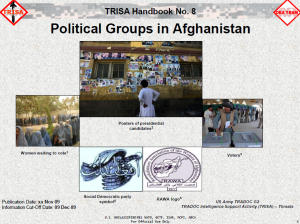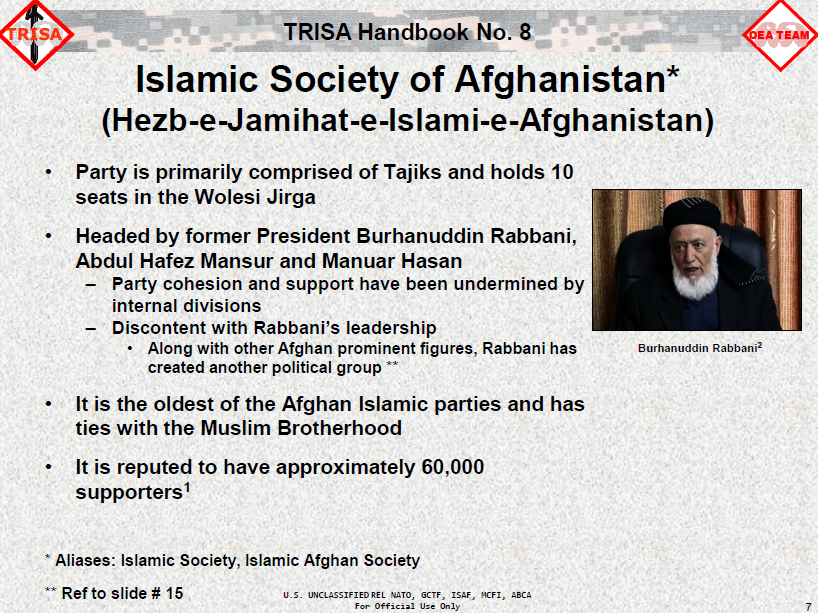TRISA Handbook 8: Political Groups in Afghanistan
- 47 pages
- REL NATO, GCTF, ISAF, MCFI, ABCA
- For Official Use Only
- December 9, 2009
Political Parties in Afghanistan
- Most political groupings in Afghanistan are based on alliances that were formed during the military struggles of 1979-2002
- Many have connections with ex-Mujahideen factions
- During the 2005 presidential election, since parties‟ identification was not allowed for candidates, party based coalition could not function in parliament
- In the 2009 presidential election, political parties could support a candidate who was a member
- In Afghanistan, political parties are seen as controversial and are not seen as a potential positive force by the government or the public
- The Political Parties Law of 2003 requires all political parties to be registered with the Ministry of Justice and observe the precepts of Islam
- Some 82 parties have gained such recognition as of the end 2007; but hundreds of political groups claim to be active in the country today, the majority of which have little to no political power
- The government fears that encouraging political parties will fuel civil tensions and contribute to the existing deteriorating security
- The government places emphasis on building national unity and preventing groups from forming in Parliament on the basis of ethnicity, language, region or any other potentially divisive factors1
- For most parties, particularly the new or smaller ones without well known leaders, their information is not known or widely disseminated
- There are numerous reasons why parties formed and are forming but two main raisons stand out:
- New opportunity
- Especially after the fall of the Taliban
- Disputes with current leadership
- Political groups in Afghanistan are very fluid, coalitions, fronts and political alliances form and dissolve quickly
- Allegiances between groups shift according to the convictions of their leaders rather than by ideology
- Individual parties split, reunify and/or rename themselves constantly, leading to confusion in party existence and names
…
Major Pro-government Parties
- Islamic Society of Afghanistan (Hezb-e-Jamihat-e-Islami-e-Afghanistan)
- Afghanistan‟s Islamic Mission Organization (Tanzim Dawat-e-Islami-e-Afghanistan)
- Islamic Unity Party of Afghanistan (Hezb-e-Wahdat-e-Afghanistan)
- National Islamic Front of Afghanistan (Hezb-e-Mahaz-e-Mili Islami-e-Afghanistan)
- Afghanistan National Liberation Front (Hezb-e-Tanzim Jabha Mili Nejat-e Afghanistan)
- Afghan Social Democratic Party (Hezb-e-Afghan Melat)
- National Movement of Afghanistan (Nahzat-e-Mili Afghanistan)
Major Opposition Parties
- The United National Front – UNF (Jabhe-ye-Motahed-e-Mili)
- New Afghanistan (Hezb-e-Afghanistan-e-Naween)
- Hezb-e-Islami Gulbuddin – HiG
- Party of Islam – HiK (Hezb-e-Islami)
- Party of Islamic Unity of The People of Afghanistan (Hezb-e-Wahdat-e Islami Mardom Afghanistan)
- National Movement of Afghanistan (Nahzat-e-Mili Afghanistan)
Other Political Parties
- Revolutionary Association of the Women of Afghanistan (RAWA)
- Rome Group
- Freedom Party of Afghanistan(Hezb-e Azadee-e-Afghanistan)
- The National Understanding Front-NUF (Jabahai Tafahim Millie)
- National Youth Union of Afghanistan (Hezb-e Hambastagi-yi Milli-yi Jawanan-i Afghanistan)
…


